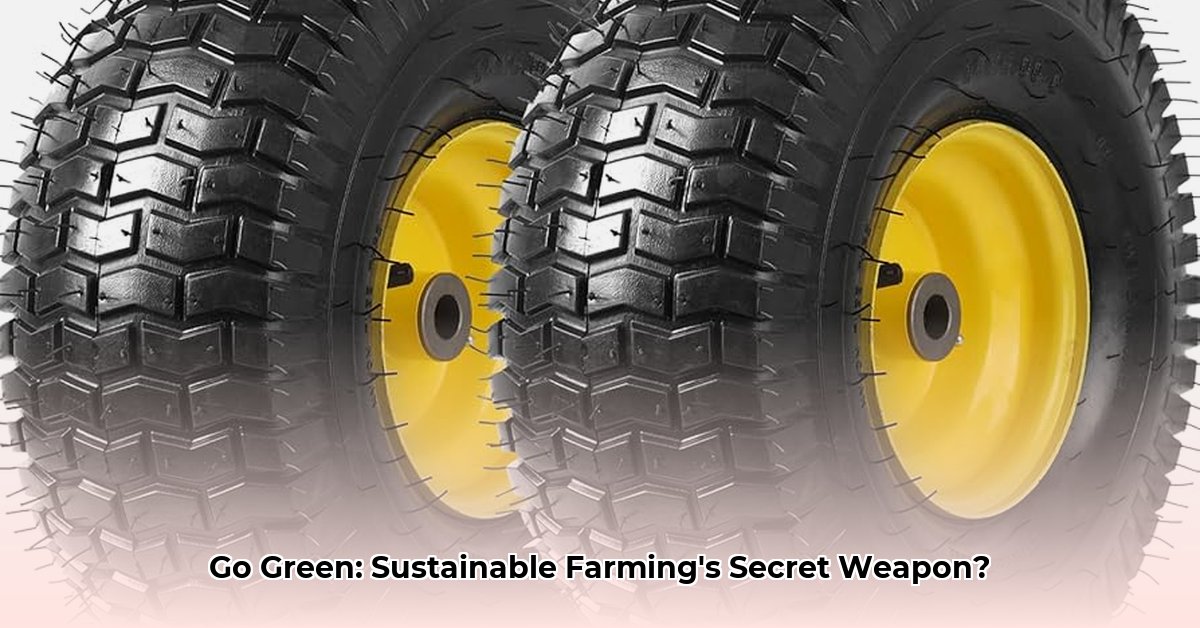
Minimizing the Environmental Footprint of Tractor Tires: A Focus on 15x6.00-6
Choosing the right tires for your tractor is a critical decision, impacting not only operational efficiency but also the long-term sustainability of your farming practices. This article focuses on the commonly used 15x6.00-6 tire, examining its lifecycle and offering actionable steps toward more sustainable agriculture. A significant challenge is the lack of readily available data on the environmental impact of these tires, a gap this article seeks to address. For more on tire options, check out this resource.
Sustainability Factors Across the 15x6.00-6 Tire Lifecycle
The environmental impact of a 15x6.00-6 tire extends beyond its simple function. Let's delve into the key sustainability factors across its lifecycle:
Material Sourcing: Recycled Rubber vs. Virgin Materials
Many 15x6.00-6 tires incorporate recycled rubber, a positive step towards environmental responsibility. However, the exact percentage of recycled rubber varies widely across manufacturers, hindering a comprehensive assessment. The lack of transparency makes it difficult to compare the environmental performance of different tires. Ideally, we need to see greater adoption of tires manufactured entirely from recycled rubber; however, technological limitations currently hinder widespread implementation. The environmental benefits of using recycled rubber are significant, reducing the demand for virgin materials and lowering energy consumption in production. This ultimately reduces the overall carbon footprint of the tire's production.
Manufacturing Process and Environmental Impact: The Hidden Costs
Tire manufacturing is an energy-intensive process, leading to greenhouse gas (GHG) emissions and contributing to climate change. Detailed data on the energy consumption and carbon footprint of producing 15x6.00-6 tires remains largely unavailable. This lack of transparency makes it challenging to determine the relative sustainability of different tire brands and models. The implementation of comprehensive lifecycle assessments (LCAs) by manufacturers is crucial to address this data gap, providing a standardized metric for comparison. These assessments would also identify opportunities to reduce energy consumption and emissions across the production process.
Soil Compaction: The Impact of Tire Pressure and Tread Pattern
Improper tire pressure significantly contributes to soil compaction, hindering water infiltration, aeration, and root growth. This impacts crop yields and overall soil health. Under-inflation causes excessive compaction, while over-inflation can lead to surface damage. Optimal tire pressure varies depending on soil type, moisture content, and the specific application.
Recommended Tire Pressures (PSI):
| Soil Type | Recommended Tire Pressure (PSI) |
|---|---|
| Sandy | 10-15 |
| Clay | 20-25 |
| Loam | 15-20 |
Note: These are general guidelines. Consult with local agricultural experts for precise recommendations tailored to your specific soil conditions.
Tread patterns also play a role. Wider, more aggressive patterns generally provide better traction while minimizing compaction.
End-of-Life Management: Recycling and Disposal
The disposal of worn-out tractor tires presents an environmental challenge. Improper disposal often results in landfilling, where tires contribute to landfill volume and can leach harmful chemicals into the environment. The development and implementation of effective tire recycling programs are essential to mitigate this environmental concern. Recycling rubber from used tires reduces reliance on virgin materials and minimizes waste.
Actionable Recommendations for Sustainable Tire Management
For Farmers:
- Regular Tire Pressure Checks: (Implement a routine of regularly checking and adjusting tire pressure based on soil conditions and usage – this can significantly reduce soil compaction)
- Tire Maintenance: (Proper maintenance, including rotation and inspection, prolongs tire lifespan, reducing replacements and minimizing waste)
- Consider Alternatives: (Explore alternative tire technologies, such as low-pressure or very-high-flexion (VF) tires, designed to reduce soil compaction)
For Manufacturers:
- Publish LCAs: (Publicly release comprehensive lifecycle assessments (LCAs) for all tire models to promote transparency and allow for comparisons)
- Increase Recycled Materials: (Increase the proportion of recycled rubber used in tire manufacturing)
- Develop Recycling Programs: (Invest in or partner with established tire recycling programs to ensure responsible end-of-life management)
For Regulators:
- Establish Sustainability Standards: (Implement stricter environmental standards for agricultural tires to incentivize sustainable manufacturing practices)
- Incentivize Recycling: (Offer financial incentives, grants, or tax breaks for farmers and manufacturers who embrace sustainable tire practices)
- Promote End-of-Life Management Programs: (Create regulations and support infrastructure for proper tire disposal and recycling)
Conclusion: A Collaborative Approach to Sustainable Agriculture
The sustainability of 15x6.00-6 tires, and agricultural tires in general, requires a collaborative effort across the industry. Increased transparency regarding material sourcing, manufacturing processes, and end-of-life management is crucial. The lack of readily available data underlines the need for more research and a commitment to sustainable practices from all stakeholders. By working together—farmers, manufacturers, policymakers, and researchers—we can create a system where sustainable agricultural practices and economic viability go hand in hand. This requires a collective commitment to transparency and innovation in agricultural tire technology.